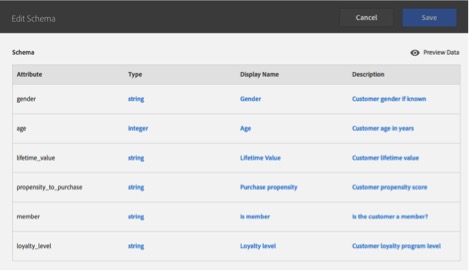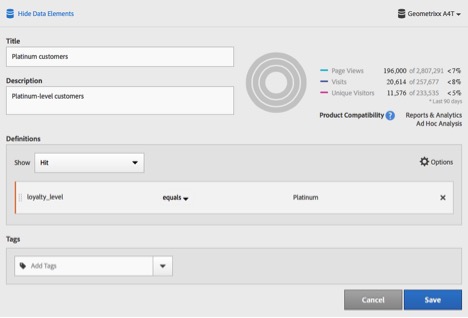Every marketing solution that exists, in every business unit across the enterprise, collects customer data and represents that data in the form of a profile listing the various attributes important to that business unit in staying in touch with that customer in the quest to make her a loyal advocate for the brand. Adobe Analytics collects customer behavior data because these people interact with the various web and mobile app properties of the brand, but it’s anonymous as to who the customer is. Adobe thinks connecting customer behavior with a description of the customer is a veritable gold mine of marketing success.
Adobe Analytics is pioneering the way as the first Solution to develop an interface with the Adobe Marketing Cloud Profiles and Audience core service.
Analytics Magic Happens Here
Let’s move forward now under the assumptions that the common Marketing Cloud ID has been created and customer records have been onboarded to the Adobe Marketing Cloud. The graphic below shows how these attributes are implemented in Adobe Analytics.
Customer attributes are manifested in Analytics as reporting dimensions and metrics. They are similar in many ways to props and eVars, but the data is stored in a new variable type so you don’t have to use up your valuable custom variables. Customer attributes are similar to props and eVars though in that they can be used in the ways shown in the graphic below.
In Adobe Analytics, customer attributes are similar to classifications in that attribute labels apply to behavioral data both forward and backward in time. However, unlike classifications, customer attributes are applied at the visitor level, which means that attributes span the entire life of the visitor cookie. Further, there are no limits to the number of visitors to which customer attributes can be applied. Finally, attributes onboarded to the Marketing Cloud are available for all Marketing Cloud workflows, not just Analytics.
When we talk about customer attributes, we are referring to non-personal labels that can be used to group behavioral data into persona groups or categories (e.g. gender, loyalty level, age group, propensity to buy, etc.) Personal data should not be onboarded to the Marketing Cloud.
Leveraging customer attributes requires certain changes to your Marketing Cloud and Analytics implementation.
First, your customers must identify themselves–typically via a login. When a person logs in you need to surface the person’s Customer ID to the page.
Second, you must then forward that Customer ID to the Marketing Cloud. The recommended means for forwarding your Customer ID requires that you implement the Marketing Cloud ID service. The easiest (and recommended) way to implement the Marketing Cloud ID service is with Dynamic Tag Management(DTM). Without DTM, you can still implement the Marketing Cloud ID service using the AppMeasurement and VisitorAPI libraries.
If you are not ready to implement the Marketing Cloud ID service but are already storing your customer ID in a prop or eVar, you can leverage that right away to get started with customer attributes. Using this option requires a simple phone call to Customer Care to get it all set up. Using a prop or eVar gives you time to implement the Marketing Cloud ID service.
Getting Started after Your Implementation Is Complete
Let’s use a CRM use case to explain the process. Assume you’re in charge of marketing for a financial services organization and you want to get your customers to sign up for a new banking service, such as a checking account. Your offline campaign included a mass mailing sent to certain customers. Now you want to know how that mailing has impacted your digital space. By incorporating the data from your CRM system, (which kept track of the offline mailings), with your behavorial analytics, which tracked the customers who signed up for the new service, you are now able to look at digital behavior from the lens of which customers received which mailers, informing your ongoing marketing decisions. Was that mailer effective? Now you know.
To get started using customer attributes, begin by having a conversation with your CRM team about what kind of customer data is available in your enterprise. Gather customer records and then upload them to the Marketing Cloud using the new customer attributes user interface in the Marketing Cloud. The process will read in your file and allow you to define names and data types.
Next, you’ll define which attributes should be pushed to which Analytics report suites.
With this complete, as users identify themselves on you site or in your apps, their attributes will be passed into Analytics where they can be used in analysis and segmentation.
Clearly, having a better view of the customer creates an opportunity to provide more precise marketing. The combination of CRM and analytics is opening doors for greater customer service by providing customers what they want, based on a more focused profile, This also creates a distinct competitive advantage by eliminating the need for your customers to do business elsewhere.
Better and More Effective Marketing
Analytics makes the entire process a closed loop, self-improving process that becomes more robust and more accurate as time goes on and you continue to collect raw CRM and analytic behavioral data. As you learn more about your customers, you can create segments in Analytics that contain a combination of attributes and behavior, and then share those segments as audiences back to the Marketing Cloud. You can then use those audiences in other places in the Marketing Cloud (e.g. Target.) The wealth of custom analytic reports grows to the point where your limitations are only one of the creative mind.
This announcement revolutionizes the way you see your customers, giving you a better view so that you can expand your marketing campaigns and customize them based on our more in-depth customer profiles and knowledge. The more you know, the better you can connect.
If you’re at the sold-out Adobe Summit, join me for some clear demonstrations and fun with analytics.



